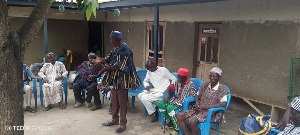 Mediation chairman engaging a section of leaders at Nakwabi
Mediation chairman engaging a section of leaders at Nakwabi
The senior, most traditional leader of Nakwabi is called Nakwabi Heuhin. Vagla history on Nakwabi suggests their first point of migration was from JANG (the First Vagla Settlement).
From Jang, the ancestors of Nakwabi moved to another ancient Vagla village called Kunlog.
Thus, the two gates, one tracing the ancestral root to the first village JANG and the other royal gate, tracing their ancestral root to KUNLOG. Currently, there are two Royal Grates to the Nakwabi Heu skin, and both sides have ascended to the skin in the past in successive times.
The beauty of the Vagla Chieftaincy system is that it revolves around Sal (Gates), and whenever it gets to one Sal (Gate), the elders of the Sal decide who is eligible to ascend the highest skin as Nakwabi Heuhin.
There are tens of past occupants of the Nakwabi Heu; below are the names of some of the past Nakwabi Heuhina.
List of traditional leaders (Earth Priest, Tendanas of Nakwabi):
Nawkabi Heuhin Boduazane
Nawkabi Heuhin Bumbile
Nawkabi Heuhin Yordaa
Nawkabi Heuhin Dongu
Nawkabi Heuhin Nakari
Nawkabi Heuhin Mwangu (Konkon)
Nawkabi Heuhin Sella (Bachagu)
Nawkabi Heuhin Sombeniiallii (Sangbo)
Santege Clan members, including Nakwabi Heuhin Dari and the immediate late
Nawkabi Heuhin Santege
Note: The list does not cover the entire Nawkabi Heuhina for over three centuries.
Nakwabi in the Vagla Chieftaincy system belongs to Korzen-Ni (Divisional Paramount). Nakwabi Heuhin is seen as a junior to Kunlog Heuhin due to some historical connections. Both villages have some common taboos, some of which may be related to Chakpalaga Kii. The people of Kunlog do not eat the wild animal called Antelope, Bush Buck.” (CHAKPALGA).
This Kunlog Taboo extends to some natives of Nakwabi. It is therefore
believed that the Nakwabi people have their last root in Kunlog, making the Nakwabi a Kunlog sub-division. By extension, Nakwabi is seen to be part of the Kunlog Traditional Area (in Vagla Chiefdom). Nakwabi is a Vagla community whose name is derived from what the founders of Nakwabi said.
NUUK))Bɛɛ. This Vagla term literally means “We heard of noise [from monkeys], and we entered and settled there. This is the meaning of the Vagla community, currently spelled Nakwabi. The founder of Nakwabi is called Nuura and
his uncle, whose roots are from Sissala Land to Jang and later to Kunlog and eventually Nakwabi.
Regarding traditional jurisdiction, the Nakwabi Heuhin has oversight responsibility for all the land shrines in Nakwabi town and all the communities within the Nakwabi Traditional Area. The Nakwabi Heuhin has subchiefs and elders who assist him in performing several sacred rites for the land and the good and well-being of the people of Nakwabi and its surrounding communities. Vagla reveres the Nakwabi Heuhin so much and will always get closer to the dear people of Nakwabi in times of joy and crisis.
It is in this regard that the KORO TINDANA COUNCIL responded urgently to the seeming chieftaincy dispute in Nakwabi on who will succeed the immediate late Nakwabi Heuhin Santege. The Council picked up the early warning signs and formed a THREE-MEMBER COMMITTEE TO MEDIATE AND FIND AN AMICABLE SOLUTION TO THE NAKWABI HEU DISPUTE THROUGH CONSENSUS.
The Three-Member Committee that mediated the Nakwabi Chieftaincy Dispute was chaired by the revered traditional leader (TENDANA/TINDANA OF TUNA), whose skin name is TUNA HEUHIN SIAYO KIPO MWIIRI II. The Committee has the blessing of the Koro Tindana Council and the blessings of the Supreme TINDANA leadership of Sornyor (Sonyo).
Below Is The Brief Report Of The Three-Member Committee:
Release For The Vagla Communities And The General Public:
The Three-Member Committee representing the Koro Tindana Council of the Savannah Region of Ghana, after the second mediation meeting of the two clan leaders (Nabonzie), youth, and other key stakeholders, ended in Nakwabi on Saturday, May 25, 2024, amicably with consensus.
The traditional leadership position of Nakwabi Heuhin was for some time vacant following the passing of the late Heuhin Santege. In the spirit of unity, the two clans could not all be present at the first meeting, thus the need for a second meeting, which was very successful.
Per the customs and practices of the Vagla, a successor to the Heu skin is to be selected within the eligible Sal (Gate). However, the misunderstanding between the two Gates made the First-Tier Conflict Resolution Mechanism of the Vagla Tribe of Gonja impossible.
The First-Tier Conflict Resolution Mechanism (Community Approach) is seen as the best option (Korbiizi Wia).
The Second Tier (Approach) was thereby activated. A Three-Member Committee
Prominent traditional chiefs and an illustrious son of the land were constituted to inquire about the dispute, leading to the Community Chieftaincy Conflict Resolution Mechanism to resolve the chieftaincy dispute in the community (Nakwabi).
The revered traditional leader of Tuna used his traditional skills of mediation, supported by the other committee members who are very experienced and well-vested in the customs and traditions of the Vagla people.
In addition, the revered caretaker of Nakwabi Heu of the Santege Gate (who stepped into the sandals of the late Heuhin and assumed the position of Heuhin) told a narrative of his people.
He and his people were present, and they shared their history and lineage with Nakwabi Heu. The other clan (Nakari Gate) leader and elders were also present, and they shared their history and lineage with the Nakwabi Heu. Both the royals of the two royal gates were there, and the chieftaincy dispute was amicably resolved with the understanding that the gate where Heuhin joined the ancestors would give way to the other side (Gate) to succeed as Heuhin.
This agreement means the rotation will be from Santege to Nakari or from Nakari to Santege from henceforth.
May the chiefs, elders, and youth of Vagla communities continue to respect and trust theirs!